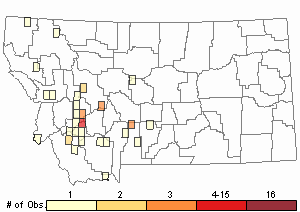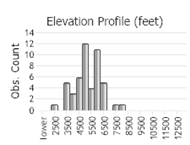View in other NatureServe Network Field Guides
NatureServe
Montana
Utah
Wyoming
Idaho
Wisconsin
British Columbia
South Carolina
Yukon
California
New York
Boreal Long-lipped Tiger Beetle - Cicindela longilabris
Native Species
Global Rank:
G5
State Rank:
S5
Agency Status
USFWS:
USFS:
BLM:
External Links
General Description
The following is taken from Pearson et al. (2015). Body length is 12-15 mm. Above dull or shiny black to dark brown (less often blue to bright green), underside dark metallic purple to blue-green or black. Forehead without hairs, upper lip (labrum) of both sexes and all forms longer than wide and is unique except for
Prairie Long-lipped Tiger Beetle (
C. nebraskana) [but see Diagnostic Characteristics]. If markings are present on elytra they may vary from three heavy whitish lines to a single thin middle line only.
Phenology
Tiger beetle life cycles fit two general categories based on adult activity periods. “Spring-fall” beetles emerge as adults in late summer and fall, then overwinter in burrows before emerging again in spring when mature and ready to mate and lay eggs. The life cycle may take 1-4 years. “Summer” beetles emerge as adults in early summer, then mate and lay eggs before dying. The life cycle may take 1-2 years, possibly longer depending on latitude and elevation (Kippenhan 1994, Knisley and Schultz 1997, Leonard and Bell 1999). Adult Cicindela longilabris, a spring-fall species, late March to early October but mostly late May to early July and again August to early September, with stragglers in between except at higher elevations where adults emerge later (Spanton 1983, Kippenhan 1994, Acorn 2001, Larochelle and Larivière 2001, Pearson et al. 2015). In Montana, adults present at least April to mid-September with peaks in May and August (Nate Kohler personal communication).
Diagnostic Characteristics
The following largely comes from Acorn (2001) and Spomer (2009). Most similar to the
Prairie Long-lipped Tiger Beetle (
C. nebraskana), which some authors consider conspecific with
C. longilabris based on molecular evidence (Spomer 2009, Pearson et al. 2015). The underside of
C. nebraskana is black, elytra smooth and shiny with only a thin middle band if any maculations present, labrum of female dark or only partially white.
C. nebraskana occupies clay soils in open grassland instead of sandy soils in grassy openings of conifer forests, but widespread areas of intergradation exist between
C. nebraskana and
C. longilabris. All morphs (including black) of
Cow Path Tiger Beetle (
C. purpurea auduboni) have hairy forehead, elytra always with white tip.
Species Range
Montana Range
Range Descriptions

 Native
Native
Range Comments
Largely a montane, foothill, and boreal species, from Alaska across boreal Canada to Newfoundland and Labrador, south to California, Arizona and New Mexico in the west, Minnesota, Wisconsin, northern Michigan in midwest, New England and New York in the east (Spanton 1983, Pearson et al. 2015). In Montana, present in montane regions of the western third (Spanton 1983, Nate Kohler personal communication); range map for this species in Pearson et al. (2015) includes C. nebraskana.
Observations in Montana Natural Heritage Program Database
Number of Observations: 50
(Click on the following maps and charts to see full sized version)
Map Help and Descriptions
Relative Density

Recency



 (Observations spanning multiple months or years are excluded from time charts)
(Observations spanning multiple months or years are excluded from time charts)
Migration
Non-migratory but capable of dispersal. When wings fully developed (macropterous), generally a strong flier and fast runner, although
C. l. laurentii considered a weak flier (Larochelle and Larivière 2001, Pearson et al. 2015).
Habitat
Adult and larval tiger beetle habitat is essentially identical, the larvae live in soil burrows (Knisley and Schultz 1997). Across the range Cicindela longilabris prefers open grassy spaces, pocket gopher mounds, paths, roadsides, blowouts, usually with sandy or gravelly areas in montane conifer forests often not associated with water or moisture, also tundra meadows above treeline (Vaurie 1950, Wallis 1961, Hooper 1969, Kippenhan 1994, Leonard and Bell 1999, Acorn 2001, Larochelle and Larivière 2001, and Pearson et al. 2015). In Montana, found in blowouts, sand pits, sparsely-vegetated areas near creeks, two tracks, unpaved roads, road cuts, trails, usually in or near conifer forest, to at least 7600 feet (2316 m) elevation (Nate Kohler personal communication).
Food Habits
Larval and adult tiger beetles are predaceous. In general, both feed considerably on ants (Wallis 1961, Knisley and Schultz 1997). Adult C. longilabris reported to feed on ants, scolytid beetles, and hemipterans (Larochelle and Larivière 2001), and probably other small insects and spiders.
Ecology
Larval tiger beetles live in burrows and molt through three instars to pupation, which also occurs in the larval burrow. Adults make shallow burrows in soil for overnight protection, deeper burrows for overwintering. Adults sensitive to heat and light and most active during sunny conditions. Excessive heat during midday on sunny days drives adults to seek shelter among vegetation or in burrows (Wallis 1961, Knisley and Schultz 1997).
Cicindela longilabris has a broad range of ecological tolerance (eurytopic). Larval burrows often scattered among open patches near sparse vegetation, average 8-20 cm deep with funnel shaped opening (Pearson et al. 2015). Adults are diurnal and nocturnal (attracted to artificial nightlights), solitary or gregarious, active at temperatures as low as 8.5°C; wary and difficult to approach, prefers to run when pursued, flight slow and heavy, in straight line up to 20 m, emits musky scent when captured. Predators include asilid (robber) flies, frogs and toads, and owls. Other associated tiger beetle species include
C. lengi,
C. limbalis,
C. purpurea,
C. terricola (=
Parvindela terricola), and
C. nebraskana (Vaurie 1950, Kippenhan 1994, Acorn 2001, and Larochelle and Larivière 2001).
Reproductive Characteristics
The life cycle of Cicindela longolabris is 3-4 years, 2-3 years as larvae (Acorn 2001, Larochelle and Larivière 2001, and Pearson et al. 2015). Mating reported in June and July, copulation lasting about 6 minutes. Oviposition occurs in May to June, pupation in June to July, fresh emerged adults from August to September, then overwinter. (Larochelle and Larivière 2001). No information for Montana.
Management
Not considered rare or in need of special conservation management (Knisley et al. 2014). Grassy openings and meadows in coniferous forest habitats, and the sandy/gravelly or clayish loamy soils favored by this species, experience vegetation encroachment and stabilization as succession proceeds, and benefit from disturbance that retains a mosaic of successional conditions. Larval burrows could be impacted by trampling through livestock overgrazing, but grazing at appropriate times and stocking levels could also be beneficial by keeping vegetation cover more open (Knisley 2011). Prescribed burning in late autumn could also be a useful tool for sustaining habitat once larvae and adults are in overwinter burrows.
References
- Literature Cited AboveLegend:
 View Online Publication
View Online Publication Acorn, J. 2001. Tiger beetles of Alberta: killers on the clay, stalkers on the sand. The University of Alberta Press, Edmonton, Alberta. 120 p.
Acorn, J. 2001. Tiger beetles of Alberta: killers on the clay, stalkers on the sand. The University of Alberta Press, Edmonton, Alberta. 120 p. Hooper, R.R. 1969. A review of Saskatchewan tiger beetles. Cicindela 1(4):1-5.
Hooper, R.R. 1969. A review of Saskatchewan tiger beetles. Cicindela 1(4):1-5. Kippenhan, Michael G. 1994. The Tiger Beetles (Coleoptera: Cicindelidae) of Colorado. 1994. Transactions of the American Entomological Society 120(1):1-86.
Kippenhan, Michael G. 1994. The Tiger Beetles (Coleoptera: Cicindelidae) of Colorado. 1994. Transactions of the American Entomological Society 120(1):1-86. Knisley, C.B. 2011. Anthropogenic disturbances and rare tiger beetle habitats: benefits, risks, and implications for conservation. Terrestrial Arthropod Reviews 4:41-61.
Knisley, C.B. 2011. Anthropogenic disturbances and rare tiger beetle habitats: benefits, risks, and implications for conservation. Terrestrial Arthropod Reviews 4:41-61. Knisley, C.B., and T.D. Schultz. 1997. The biology of tiger beetles and a guide to the species of the south Atlantic states. Virginia Museum of Natural History Special Publication Number 5. 210 p.
Knisley, C.B., and T.D. Schultz. 1997. The biology of tiger beetles and a guide to the species of the south Atlantic states. Virginia Museum of Natural History Special Publication Number 5. 210 p. Knisley, C.B., M. Kippenhan, and D. Brzoska. 2014. Conservation status of United States tiger beetles. Terrestrial Arthropod Reviews 7:93-145.
Knisley, C.B., M. Kippenhan, and D. Brzoska. 2014. Conservation status of United States tiger beetles. Terrestrial Arthropod Reviews 7:93-145. Kohler, Nathan S. Excel spreadsheets of tiger beetle observations. 6 August 2022.
Kohler, Nathan S. Excel spreadsheets of tiger beetle observations. 6 August 2022. Larochelle, A and M Lariviere. 2001. Natural history of the tiger beetles of North America north of Mexico. Cicindela. 33:41-162.
Larochelle, A and M Lariviere. 2001. Natural history of the tiger beetles of North America north of Mexico. Cicindela. 33:41-162. Leonard, Jonathan G. and Ross T. Bell, 1999. Northeastern Tiger Beetles: a field guide to tiger beetles of New England and eastern Canada. Boca Raton, FL: CRC Press. 176 p.
Leonard, Jonathan G. and Ross T. Bell, 1999. Northeastern Tiger Beetles: a field guide to tiger beetles of New England and eastern Canada. Boca Raton, FL: CRC Press. 176 p. Pearson, D.L., C.B. Knisley, D.P. Duran, and C.J. Kazilek. 2015. A field guide to the tiger beetles of the United States and Canada, second edition. New York, NY: Oxford University Press. 251 p.
Pearson, D.L., C.B. Knisley, D.P. Duran, and C.J. Kazilek. 2015. A field guide to the tiger beetles of the United States and Canada, second edition. New York, NY: Oxford University Press. 251 p. Spanton, T.G. 1983. A revision of the Nearctic species of the cicindela sylvatica group (Coleopter: Cicindelidae). M.Sc. Thesis. Thunder Bay, Ontario: Lakehead University. 175 p. + figures.
Spanton, T.G. 1983. A revision of the Nearctic species of the cicindela sylvatica group (Coleopter: Cicindelidae). M.Sc. Thesis. Thunder Bay, Ontario: Lakehead University. 175 p. + figures. Spomer, S.M. 2009. A taxonomic study of populations of tiger beetles in the Cicindela longilabris complex from the Black Hills of South Dakota. Great Plains Research 19:196-177.
Spomer, S.M. 2009. A taxonomic study of populations of tiger beetles in the Cicindela longilabris complex from the Black Hills of South Dakota. Great Plains Research 19:196-177. Vaurie, P. 1950. Notes on the habitats of some North American tiger beetles. Journal of the New York Entomological Society 58(3):143-153.
Vaurie, P. 1950. Notes on the habitats of some North American tiger beetles. Journal of the New York Entomological Society 58(3):143-153. Wallis, J.B. 1961. The Cicindelidae of Canada. Toronto, Ontario, Canada: University of Toronto Press. 74 p.
Wallis, J.B. 1961. The Cicindelidae of Canada. Toronto, Ontario, Canada: University of Toronto Press. 74 p.
- Additional ReferencesLegend:
 View Online Publication
View Online Publication
Do you know of a citation we're missing? Bousquet, Yves. 2012. Catalogue of Geadephaga (Coleoptera; Adephaga) of America north of Mexico. ZooKeys. 245:1-1722.
Bousquet, Yves. 2012. Catalogue of Geadephaga (Coleoptera; Adephaga) of America north of Mexico. ZooKeys. 245:1-1722. Hendricks, P. and M. Roedel. 2001. A faunal survey of the Centennial Valley Sandhills, Beaverhead County, Montana. Report to the U.S. Bureau of Land Management and U.S. Fish and Wildlife Service. Montana Natural Heritage Program, Helena, MT. 44 p.
Hendricks, P. and M. Roedel. 2001. A faunal survey of the Centennial Valley Sandhills, Beaverhead County, Montana. Report to the U.S. Bureau of Land Management and U.S. Fish and Wildlife Service. Montana Natural Heritage Program, Helena, MT. 44 p. Pearson, D.L., C.B. Knisley, and C.J. Kazilek. 2006. A field guide to the tiger beetles of the United States and Canada: identification, natural history, and distribution of the Cicindelidae. Oxford University Press, New York, New York. 227 pp.
Pearson, D.L., C.B. Knisley, and C.J. Kazilek. 2006. A field guide to the tiger beetles of the United States and Canada: identification, natural history, and distribution of the Cicindelidae. Oxford University Press, New York, New York. 227 pp.
- Web Search Engines for Articles on "Boreal Long-lipped Tiger Beetle"
- Additional Sources of Information Related to "Insects"





